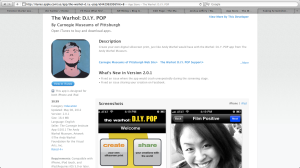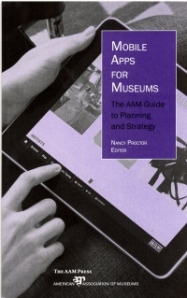An Interview with Joshua Jefferey, Manager of Digital Engagement at the Andy Warhol Museum
Joshua Jefferey is the Manager of Digital Engagement at the Andy Warhol Museum in Pittsburgh, and worked on the development of the smash hit mobile App, DIY POP. He sat down with Elyssa Jechow to talk about the App, its success, and the relevance of instituting technology into the practices of today’s arts institutions.
Elyssa Jechow: Can you tell me how the idea for the DIY POP mobile App came about?
Joshua Jeffrey: This idea really came from the education department, and Tresa Varner, the Curator for Education. One of the things we’ve been doing for a very long time in our studio is to let people do silk screen printing.

The Warhol Museum recognized that many fans are mobile-savvy, and has developed an app that lets its constituents enhance their Warhol experience via mobile technology.
What the education department realized, though, is that a lot of folks aren’t familiar with the process of silk screen printing, or that they thought it was this computer thing, because of the pop filter on the MacBook.
We thought, “Why don’t we create an app that lets you make your own Warhol portrait, but really teach the process?”
That’s how we created the framework of the app.
EJ: One of the things that strikes me about the app is that it is so simple, yet comprehensively teaches and raises awareness of what you are trying to accomplish. Can you explain how you obtained that balance?
JJ: What we did was to take a look at the real silkscreen process, and did a one-to-one translation of each step. We really just looked to the original process. There are obviously certain things that get lost or added along the way. We made a conscious choice, say, in the “exposure” step, that we’re going to let you tap the light bulb. Maybe we didn’t really need that step, but we made conscious decisions about what we did.
The by-product of translating into digital, though, is that you have to pick and choose what you will include and what you will leave out. In developing the app, we spent a lot of time being as authentic to the process as we could. We hit a lot of questions where, in a digital sense, we could do X, but we didn’t do X.
EJ: So many museum apps are available only when you are inside the museum. Can you tell me why you chose to develop an app that is available worldwide 24/7?
JJ: This app should be as available and viral as possible. We have 120,000 visitors every year, 440,000 followers on Twitter, and millions visit our website. Believe it or not, we are the seventh most followed museum in the world [on the internet]. So we know our digital audience is global and young. We had to build an app for them.
It is an “augmentational” app. Sure, it can be used in the museum, but it is also for people not at the museum. The development of apps is really determined by the audience.
EJ: What has been the response to the addition of the app?
JJ: Well, the response has actually been mixed, and is getting better. When we first launched, you were either one of two camps – you either really loved it or didn’t. People who really liked the app tended to be artistic (as in they like drawing apps), or fans of Warhol.
People who didn’t like the app were the “iPhonographers,” (iPhone photographers). They, on the other hand, like photo apps, and were not happy about the resolution and print quality, things like that. They wanted to create actual works and prints, but that just wasn’t possible. With the original version of the app, you really had to experiment to get good at it.
However, we have updated, tweaked the algorithm, and added an exposure step to allow people to see what the final image is going to look like. We also fixed a few bugs, and the resulting image is 350% larger than before.
EJ: What have been the benefits of introducing the app?
JJ: We have definitely gotten a ton of press – the Associated Press, The Wall Street Journal, and The New York Times picked us up. Anything Warhol is hot right now – he’s still incredibly important and pertinent – and the exposure has really helped bring light to this.
I’ve also been fortunate to talk about the app at conferences. It’s kind of the first app from a museum that focuses on a process instead of just the collection or the art itself.

Technology in arts experiences is becoming more and more relevant. The American Association of Museums has developed a guidebook to help museums integrate technology. Image courtesy of http://www.aam-us.org.
EJ: Word on the street is that the Warhol has some other apps in the works. Can you tell me about them?
JJ: We do. We have some ideas in relation to Andy Warhol’s Time Capsules. But we are bouncing back and forth because technology changes underneath us. We really have to go back to the drawing board and re-think it – we want to have the most appropriate use of Apps.
The idea, though, is that you pay for a subscription, and you would get real-time updates as the Time Capsules are opened.
We are also planning on formally opening the collection online, which will have mobile components. In addition, in the fall, we’ll be releasing Time Web. This app will contextualize the collection with real world events that were happening at the same time that Warhol was producing work.
EJ: In today’s world of technology, the Internet at people’s fingertips, and real-time communication, why do you think it is important for arts institutions to embrace technology?
JJ: It’s sort of required now. Museums are particularly at fault for not implementing technology. The core of our mission is to “preserve old stuff.” I think there is a fear that technology will outshine the art. In reality, it should augment the art or the visit – put the artwork at the center of the experience.
In my mind, nothing will ever beat standing in front of the piece. But, since we are competing with every other entertainment venue [movies, sports, etc.], we have to at least be on the same playing field in terms of technology.
Think about it – people will stand in line for hours for an iPhone, so we have to excite people about being able to integrate that gadget into their museum experience.
I think we did that with DIY POP. People got excited about and App that was about Andy.
For more information on apps and other ways you can connect with the Warhol, click here.
For related articles from The Muse Dialogue:
Vol.1, No. 10: Arts and Technology Table of Contents
Talking Back to the Art through New Technologies









